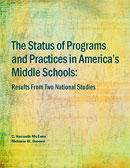Data from past and present middle level programs and practices supports middle school concept as key factor in highly successful middle schools
The early 1900s marked the beginning of American education moving from a two-tiered to a three-tiered structure—from elementary and senior high schools to elementary, middle level, and senior high schools. This movement, and the middle school movement that emerged in the 1960s, were developed for multiple reasons, including the need to provide young adolescents with developmentally responsive learning environments by employing programs and practices that promote healthy development and maximize learning. While this effort, also called the middle school concept or philosophy, resulted in many significant accomplishments, a lingering problem found in many schools that contain the middle grades is the lack of authentic full implementation of the programs and practices recommended in the middle level literature and the middle level research base.
Several national surveys of middle level programs and practices have been conducted since the first middle schools were established. One of the surveys reported on in this publication is the fifth linked survey that began with a classic survey conducted by William M. Alexander in 1968.
In this latest survey, data from 827 random middle schools are provided along with a second survey that collected data from 101 of the most successful middle level schools in the nation to help identify successful programs and practices and to determine whether these schools were following the middle school concept. The Status of Programs and Practices in America’s Middle Schools: Results from Two National Studies provides evidence and includes a series of conclusions that some of the most successful middle schools in the nation are implementing programs and practices supported by the middle level knowledge base. This report presents data representing past and current middle level programs and practices and includes lessons that can be learned from highly successful middle schools.
![]() The Status of Programs and Practices in America’s Middle Schools: Results from Two National Studies
The Status of Programs and Practices in America’s Middle Schools: Results from Two National Studies
![]() Executive Summary
Executive Summary
